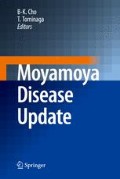Abstract
Ikeda et al. performed a genome-wide linkage study using 16 Japanese families with moyamoya disease and 371 microsatellite markers [1]. In the study 13 of 16 families had sibling cases and the rest of them included parent—children transmission of the disease. Maximum nonparametric linkage (NPL) score of 3.4 was found at the marker D3S3050. NPL score of greater than 3.0 was observed at the three microsatellite markers, D3S2387, D3S3050, and D3S1560, which are located on chromosome 3p24.2-p26 (Fig. 1). In moyamoya disease, abnormal vascular formation is observed mainly in brain. Marfan syndrome is an extracellular matrix disorder with cardinal manifestations in the cardiovascular and skeleton systems. Moyamoya-like angiographic findings are sometimes associated with Marfan syndrome. Most patients with Marfan syndrome have mutations in fibrillin gene (FRN) on chromosome 15q21 [2]. The second locus for Marfan syndrome has been mapped at chromosome 3p25-24.2 [3]. Recently, TGFBR2, a putative tumor-suppressor gene implicated in several malignancies, has been identified for the second gene for Marfan syndrome [4]. Mutational analysis of TGFBR2 in patients with moyamoya disease has not been reported. Yamamoto et al. hypothesized that paternally imprinted gene might be associated with this disorder because of a high incidence of maternal inheritance in familial moyamoya disease. Although they screened genes with monoallelic expressions on chromosome 3, no imprinting gene was identified in this region [5].
Access this chapter
Tax calculation will be finalised at checkout
Purchases are for personal use only
References
Ikeda H, Sasaki T, Yoshimoto T et al (1999) Mapping of a familial moyamoya disease gene to chromosome 3p24.2-p26. Am J Hum Genet 64:533–537
Dietz HC, Cutting GR, Pyeritz RE et al (1991) Marfan syndrome caused by a recurrent de novo missense mutation in the fibrillin gene. Nature 352:337–339
Collod G, Babron MC, Jondeau G et al (1994) A second locus for Marfan syndrome maps to chromosome 3p24.2-p25. Nat Genet 8:264–268
Mizuguchi T, Collod-Beroud G, Akiyama T et al (2004) Heterozygous TGFBR2 mutations in Marfan syndrome. Nat Genet 36:855–860
Yamamoto T, Akasaka Y, Ohtani K et al (2005) Molecular screening for moyamoya disease by use of expressed sequence tag on chromosome 3p. No To Hattatsu 37:20–25
Aoyagi M, Ogami K, Matsushima Y et al (1995) Human leukocyte antigen in patients with moyamoya disease. Stroke 26:415–417
Inoue TK, Ikezaki K, Sasazuki T et al (1997) DNA typing of HLA in the patients with moyamoya disease. Jpn J Hum Genet 42:507–515
Inoue TK, Ikezaki K, Sasazuki T et al (2000) Linkage analysis of moyamoya disease on chromosome 6. J Child Neurol 15:179–182
Han H, Pyo CW, Yoo DS et al (2003) Associations of moyamoya patients with HLA class I and class II alleles in the Korean population. J Korean Med Sci 18:876–880
Sakurai K, Horiuchi Y, Ikeda H et al (2004) A novel susceptibility locus for moyamoya disease on chromosome 8q23. J Hum Genet 49:278–281
Yamamoto M, Aoyagi M, Fukai N et al (1998) Differences in cellular responses to mitogens in arterial smooth muscle cells derived from patients with moyamoya disease. Stroke 29:1188–1193
Hojo M, Hoshimaru M, Miyamoto S et al (1998) Role of transforming growth factor-beta1 in the pathogenesis of moyamoya disease. J Neurosurg 89:623–629
Yamauchi T, Tada M, Houkin K et al (2000) Linkage of familial moyamoya disease (spontaneous occlusion of the circle of Willis) to chromosome 17q25. Stroke 31:930–935
Nanba R, Tada M, Kuroda S (2005) Sequence analysis and bioinformatics analysis of chromosome 17q25 in familial moyamoya disease. Childs Nerv Syst 21:62–68
Kang HS, Kim SK, Cho BK et al (2006) Single nucleotide polymorphisms of tissue inhibitor of metal-loproteinase genes in familial moyamoya disease. Neurosurgery 58:1074–1080; discussion-80
Johnson C, Galis ZS (2004) Matrix metalloproteinase-2 and -9 differentially regulate smooth muscle cell migration and cell-mediated collagen organization. Arterioscler Thromb Vasc Biol 24:54–60
Mineharu Y, Liu W, Inoue K et al (2008) Autosomal dominant moyamoya disease maps to chromosome 17q25.3. Neurology 70:2357–2363
Shiratsuchi T, Oda K, Nishimori H et al (1998) Cloning and characterization of BAP3 (BAI-associated protein 3), a C2 domain-containing protein that interacts with BAI1. Biochem Biophys Res Commun 251:158–165
Meschia JF, Ross OA (2008) Heterogeneity of moyamoya disease:after a decade of linkage, is there new hope for a gene? Neurology 70:2353–2354
Author information
Authors and Affiliations
Editor information
Editors and Affiliations
Rights and permissions
Copyright information
© 2010 Springer
About this chapter
Cite this chapter
Kure, S. (2010). Genetic Linkage Study. In: Cho, BK., Tominaga, T. (eds) Moyamoya Disease Update. Springer, Tokyo. https://doi.org/10.1007/978-4-431-99703-0_7
Download citation
DOI: https://doi.org/10.1007/978-4-431-99703-0_7
Publisher Name: Springer, Tokyo
Print ISBN: 978-4-431-99702-3
Online ISBN: 978-4-431-99703-0
eBook Packages: MedicineMedicine (R0)

